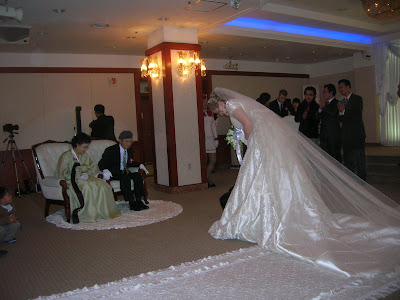Following is a smattering of pictures and clever accompanying comments from Korea. Think of it as a photo montage, like the type they show after the Olympics, World Cup, and major natural disasters.
Korea is cold, and as we all know, trees get cold as well. These trees are bundled up for the winter. They will provide the cherry blossoms in the next Cherry Blossom Festival.

Here are a few pictures of palaces and royal shrines. After a while they all kind of run together, much like runners in the New York Marathon.



Korean food doesn't agree with everyone. Here I am comforting my little bro as he seeks comfort in a large palace urn.

Here's a picture capturing the pageantry of the changing of the guard.

Koreans drink water out of little envelopes! They’re so funny!

One of the cool places we went was Isadong, which is old town Korea. It was biting cold the first night so we dropped into a traditional Teahouse. It looked like a little hobbit hole.

On the street vendors sell little cakes filled with sweetened red beans.

They’re quite tasty and they quickly became the only thing my father would eat. He began to look for them in the strangest places.

Koreans like to put up signs. This street is well signed.

Koreans also like to exercise and you don’t see many fat Koreans. These pieces of exercise equipment are clearly the reason why:



Even though the weather was about 30 degrees F, a very common activity is to see tons of old men out playing Chinese chess or Go.
Here my brother is being taught Chinese chess by a man that does not speak English. They had to communicate through the international language, love.

Here is my new niece in law, Harang (yes, that’s an official relation). She likes to bow to you.


Here we are at a market.

This kimchi is called bachelor kimchi, not because the radishes look like penises, but because…oh wait, no that’s why.

I really didn’t make that one up.
Here we are in front of the great south gate of the wall that used to surround Seoul

Korean Ginseng is put into everything. It’s a natural aphrodisiac, like me.

We visited a couple Buddhist temples (you know how I love those). These lanterns seem to hang over the entrance to most complexes.

Here’s the whole clan headin home after a day spent walking ‘til the seouls of our feet ached.

Here we are being captured by a huge wicker dragon.

The etiquette bell is the greatest modern Korean invention. They are located in many ladies’ restrooms. It makes a sound like a flushing toilet. When a lady uses the toilet, it is considered improper to make…sounds. Thus the etiquette bell is pushed when sounds are being made. I’m thinking of making it portable and marketing it in the US, any venture capitalists reading this??

That’ll about do it for Korea. I wrote this as I was suspended somewhere over the Rocky Moutains on my way back to Austin. So it's time I hang up my keyboard 'til the next trip.






















